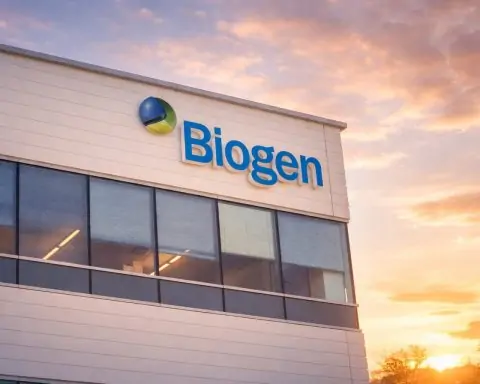Pharmaceutical Industry News (Approvals, Trials & Deals)
- FDA Greenlights New Rare Disease Therapies: The U.S. FDA approved two cutting-edge treatments for rare conditions. Ionis Pharmaceuticals’ Dawnzera (donidalorsen) won approval to prevent hereditary angioedema (HAE) attacks, after trials showed it cut monthly swelling episodes by 81% [1]. “[Donidalorsen] is positioned to help meet patient needs, providing substantial and sustained reduction of HAE attacks… and reduced burden of treatment,” said Dr. Marc Riedl of UC San Diego, an investigator in the OASIS-HAE trial [2]. And in a historic first for a viral immunotherapy, Precigen’s Papzimeos was approved for recurrent respiratory papillomatosis, eliminating the need for repeated surgeries in many patients [3] [4]. “Today marks a historic turning point… all adult RRP patients are now eligible for access to the first and only approved therapy that targets the root cause of the disease,” declared Precigen CEO Helen Sabzevari [5].
- Big Pharma M&A Accelerates: Pharma giants struck acquisitions to bolster their pipelines. Gilead’s Kite Pharma is acquiring Interius BioTherapeutics for $350 million to harness its in vivo CAR-T gene delivery platform [6]. Kite’s EVP Cindy Perettie noted “in vivo therapy is a promising frontier… By combining Interius’s novel platform with Kite’s expertise, we aim to advance best-in-class in vivo therapies to bring them to patients more efficiently.” [7] Similarly, XOMA Corporation’s royalty arm agreed to buy Mural Oncology for up to $36 million [8] [9]. “This transaction… achieves the goal of our strategic review to maximize shareholder value,” said Caroline Loew, PhD, Mural’s CEO [10], highlighting the premium paid to investors.
- Major Investments and Market Moves: Industry leaders are ramping up production capacity amid geopolitical pressures. Johnson & Johnson announced a $2 billion investment to build a state-of-the-art biomanufacturing facility in North Carolina, creating 120 jobs [11] [12]. “Johnson & Johnson has more manufacturing facilities in the US than any other country, and we continue to strengthen our presence here,” CEO Joaquin Duato said, citing a commitment to U.S. innovation under new tariff policies [13]. In India, Apollo Hospitals Enterprise saw a major shareholder divest a ₹14.89 billion ($170 million) stake via a block trade [14]. About 1.9 million shares (1.25% equity) were sold at a slight discount [15], reportedly by Managing Director Suneeta Reddy, signaling significant portfolio shifts in Asia’s hospital sector.
Biotech Startups & Funding Highlights
- Startup Showcase – Singapore’s Golden Ticket: Amid a tight funding climate, bright spots emerged in biotech innovation. Singzyme, a Singaporean biotech startup, won Amgen’s 2025 Golden Ticket award for its breakthrough bioconjugation platform [16] [17]. The prize grants Singzyme a year’s free lab space and mentorship to advance its peptide ligation technology for next-gen antibody-drug conjugates [18] [19]. “Singzyme’s novel platform reflects the strong scientific thinking and innovation emerging from Singapore’s biotech sector,” said Dr. Alan Russell, Amgen’s VP of Research Biologics, praising the startup’s approach to improving targeted cancer therapies [20]. The Golden Ticket program, now in its fourth year, has helped past winners secure funding – Albatroz Therapeutics raised $3 million seed financing after winning, and VerImmune closed a pre-Series A round on the program’s momentum [21].
- Funding Environment – Resilience Amid Slowdown: Overall biotech venture funding remains challenging in 2025, with global VC investments dropping sharply in Q2 (down ~57% year-on-year) [22]. Yet companies with strong science continue to attract capital. For example, Kriya Therapeutics raised $313 million (one of the year’s largest financings) to fuel its gene therapy pipeline [23]. Investors are increasingly selective, backing startups like Singzyme that address clear unmet needs or leverage AI and novel platforms. Analysts note that big pharma partnerships and incubator programs have become vital lifelines for emerging biotechs, providing not just money but R&D support to bridge the funding gap until market conditions improve.
Medical Research Breakthroughs & Publications
- Hearing Aids and Dementia Prevention: A long-term population study offers compelling new evidence that treating hearing loss may protect the brain. Researchers tracking nearly 3,000 older adults in the Framingham Heart Study found that people under 70 who used hearing aids had a 61% lower risk of developing dementia over ~20 years [24]. The JAMA Neurology report observed no significant dementia reduction in those over 70 starting hearing aids [25], suggesting earlier intervention is critical. This large-scale study, with 20% of participants developing dementia, bolsters the case that mid-life hearing care can substantially curb neurodegenerative risk [26] [27]. Experts call the findings a potential game-changer for public health: addressing hearing loss in middle age could delay or prevent thousands of dementia cases, underscoring “the importance of early intervention for hearing loss for possible prevention of dementia.” [28]
- Phantom Limbs Rewrite Brain “Plasticity” Textbook: In a groundbreaking Nature Neuroscience study, NIH scientists discovered that the human brain’s map of the body remains surprisingly stable even after limb amputation. They performed fMRI scans on patients before and after arm amputations over five years and found “little to no difference” in the brain’s hand-area activity maps post-amputation [29]. This defies the longstanding theory that the cortex rapidly remaps itself (with neighboring regions overtaking the area for the missing limb). “For many decades, cortical remapping after amputation has been a literal textbook example of brain plasticity,” noted co-author Dr. Chris Baker of NIMH – but the persistence of the hand’s representation, even when the limb is gone, suggests the brain “remembers” the missing limb [30]. The phantom limb phenomenon, often causing vivid sensations in an absent arm or leg, now has an explanation: the brain’s original neural circuits endure. This insight could drive new approaches in neuroprosthetics and pain management for amputees [31] [32], by leveraging the brain’s preserved maps rather than trying to retrain them.
Healthcare Policy & Public Health Developments
- US Health Agencies Overhaul Care Delivery: The U.S. Department of Health and Human Services (HHS) and Centers for Medicare & Medicaid Services (CMS) announced a new federal advisory panel to recommend improvements in how care is financed and delivered across insurance programs [33]. The expert committee will report directly to HHS Secretary Robert F. Kennedy Jr. and CMS chief Dr. Mehmet Oz, focusing on cutting red tape and modernizing services. “This committee will help us cut waste, reduce paperwork, expand preventive care and modernize CMS programs with real-time data and accountability, all while keeping patients at the center,” Dr. Oz said in a statement [34]. Priorities include managing chronic diseases better and streamlining insurance billing using data tools [35]. CMS is soliciting nominations for 15 panel members (including experts in public health, healthcare finance, and delivery reform) to be appointed later this year [36].
- Tumult at U.S. Health Agencies – CDC Layoffs & Staff Backlash: Turmoil hit the CDC and HHS as the Trump administration continued its shake-up of federal health agencies. The CDC quietly laid off 500–600 employees this week, according to The Washington Post, marking a dramatic downsizing in the nation’s public health workforce [37]. These permanent terminations are part of a broader purge of health agencies’ staff, coming on the heels of earlier leadership changes. Meanwhile, 750 HHS employees sent an open letter to Secretary RFK Jr., decrying his “dangerous and deceitful statements and actions” regarding vaccines and public health measures [38]. The career staff accuse Kennedy – a known vaccine skeptic – of eroding trust and endangering the public with misinformation. The rare rebuke from HHS’s own ranks underscores internal alarm at the direction of federal health policy. Observers say morale at the agencies has plummeted, even as they face pressing issues from pandemic recovery to opioid crisis response.
- Global Trade Deal to Cap Drug Tariffs: In international policy news, the White House and European Union finalized a trade agreement that will limit tariffs on pharmaceuticals to 15% [39] [40]. The pact, set to take effect September 1, comes after months of threats to impose much steeper duties on drug imports – up to 250% at one point [41]. Under the deal, neither side will levy more than a 15% duty on medicines, APIs, or medical devices, ensuring “reciprocal, fair, and balanced” trade in health products [42]. The EU also committed to invest $600 billion in U.S. projects and increase purchases of American energy [43]. Industry experts breathed a sigh of relief, noting this compromise averts a potential cost shock for drug supply chains. “If we were buying a finished pharmaceutical and it got a 250% tariff, the cost implications would be significant,” warned supply-chain advisor Dave Malenfant [44] [45]. By capping tariffs, the US-EU accord aims to stabilize medicine prices and prevent shortages, while still encouraging more domestic manufacturing – as evidenced by J&J, Lilly, and other pharma firms announcing major U.S. investments in response to tariff pressures [46] [47].
- Measles Resurgence Sparks Vaccination Calls: Public health officials globally are sounding the alarm over resurgent measles outbreaks. The Pan American Health Organization reported 10,139 measles cases and 18 deaths across 10 countries in the Americas as of mid-August – a 34-fold increase from the same period last year [48]. Hard-hit regions include Mexico (14 deaths, mostly in under-immunized communities) and the United States (3 deaths) [49] [50]. Over 70% of cases occurred in unvaccinated individuals [51]. “Measles is preventable with two doses of a vaccine… To stop these outbreaks, countries must urgently strengthen routine immunization and conduct targeted vaccination campaigns in high-risk communities,” urged Dr. Daniel Salas, PAHO’s immunization chief [52]. The WHO likewise warned that lapses in childhood vaccination during the pandemic are now manifesting in renewed outbreaks. Health agencies are racing to close immunization gaps – for example, the CDC noted U.S. kindergarten MMR vaccine coverage slipped to 93% in 2024, below the level needed for herd immunity [53]. The measles flare-up is a sobering reminder that diseases once eliminated can return if vaccine complacency sets in, prompting calls for aggressive vaccination drives to prevent a wider public health crisis.
Regulatory Updates from Agencies (FDA, EMA, etc.)
- FDA Approval Blitze: Along with the headline approvals of Dawnzera and Papzimeos noted above, the FDA cleared several other therapies. Notably, Ionis’s Dawnzera (donidalorsen) is one of three new HAE prophylactics approved in 2025, reflecting rapid innovation in rare disease treatment [54] [55]. Priced at $57,462 per dose [56], Dawnzera offers higher efficacy and more convenient dosing (monthly injections) compared to older drugs like Takeda’s Takhzyro [57]. Precigen’s Papzimeos (zopapogene imadenovec), a first-in-class adenoviral immunotherapy, similarly stands out as the only FDA-approved therapy for recurrent respiratory papillomatosis [58] [59] – an advance 100+ years in the making. Both approvals were granted on August 21, capping a busy summer for the FDA’s review teams.
- FDA Rejection Highlights Efficacy Bar: In contrast, the FDA issued a high-profile Complete Response Letter (CRL) rejecting PTC Therapeutics’ vatiquinone for Friedreich’s ataxia. In the Aug 19 CRL, regulators concluded that “substantial evidence of efficacy was not demonstrated for vatiquinone” and advised that an additional well-controlled trial is needed [60] [61]. “We are of course disappointed by the FDA’s decision to not approve vatiquinone,” PTC’s CEO Matthew Klein said, vowing to gather more data [62]. The decision dashed hopes of the first approved therapy for this debilitating genetic disease. FDA’s stance underlines its higher bar for efficacy, even in rare diseases with unmet need – a reminder that promising phase 2 signals often must be confirmed by robust phase 3 results before approval.
- Global Regulatory Notes: Elsewhere, regulators advanced other notable medicines. The European Medicines Agency (EMA) is reviewing NewAmsterdam Pharma’s obicetrapib, a cholesterol drug that intriguingly also slowed Alzheimer’s biomarkers in a trial [63] [64]. China’s NMPA granted priority review to Brii Biosciences’ new hepatitis B therapy (as the company reported in its Q2 update) [65]. And the World Health Organization released new guidance on water and sanitation in healthcare facilities [66] – part of its push to curb infections and antimicrobial resistance by improving basic infrastructure. Many clinics in low-resource settings still lack clean running water [67]. The WHO’s toolkit helps policymakers select appropriate water supply and wastewater treatment technologies for hospitals [68], with recommendations to enhance climate resilience and align with the Sustainable Development Goals [69]. This emphasizes a broader view of “health security” that includes strong public health systems and preparedness, complementing the high-profile efforts on pandemic treaty negotiations and emergency response planning ongoing at the WHO.
Sources: Scientific press releases, company announcements, major news outlets (Reuters, AP, HealthDay, FierceBiotech, etc.), and health agency briefs were used to compile this report [70] [71] [72] [73]. Each item includes a citation link to the original source for further reading. This concludes the comprehensive roundup of biotech, pharma, medical, and health news from August 21–22, 2025.
References
1. www.reuters.com, 2. www.hcplive.com, 3. www.drugs.com, 4. www.drugs.com, 5. www.drugs.com, 6. www.reuters.com, 7. interiusbio.com, 8. www.pharmexec.com, 9. www.pharmexec.com, 10. www.pharmexec.com, 11. www.reuters.com, 12. www.reuters.com, 13. www.pharmaceuticalcommerce.com, 14. www.reuters.com, 15. www.reuters.com, 16. laotiantimes.com, 17. laotiantimes.com, 18. laotiantimes.com, 19. laotiantimes.com, 20. laotiantimes.com, 21. laotiantimes.com, 22. www.biopharmadive.com, 23. www.fiercebiotech.com, 24. www.neurologylive.com, 25. www.neurologylive.com, 26. www.neurologylive.com, 27. www.neurologylive.com, 28. www.neurologylive.com, 29. www.nih.gov, 30. www.nih.gov, 31. www.nih.gov, 32. www.nih.gov, 33. www.reuters.com, 34. www.reuters.com, 35. www.reuters.com, 36. www.reuters.com, 37. kffhealthnews.org, 38. kffhealthnews.org, 39. www.pharmaceuticalcommerce.com, 40. www.pharmaceuticalcommerce.com, 41. www.pharmaceuticalcommerce.com, 42. www.pharmaceuticalcommerce.com, 43. www.pharmaceuticalcommerce.com, 44. www.pharmaceuticalcommerce.com, 45. www.pharmaceuticalcommerce.com, 46. www.reuters.com, 47. www.reuters.com, 48. ts2.tech, 49. ts2.tech, 50. ts2.tech, 51. ts2.tech, 52. ts2.tech, 53. ts2.tech, 54. www.biopharmadive.com, 55. www.reuters.com, 56. www.reuters.com, 57. www.reuters.com, 58. www.usnews.com, 59. www.drugs.com, 60. ir.ptcbio.com, 61. www.nasdaq.com, 62. www.fiercebiotech.com, 63. www.neurologylive.com, 64. www.neurologylive.com, 65. www.biospace.com, 66. www.who.int, 67. www.who.int, 68. www.who.int, 69. www.who.int, 70. www.reuters.com, 71. www.reuters.com, 72. ts2.tech, 73. interiusbio.com










